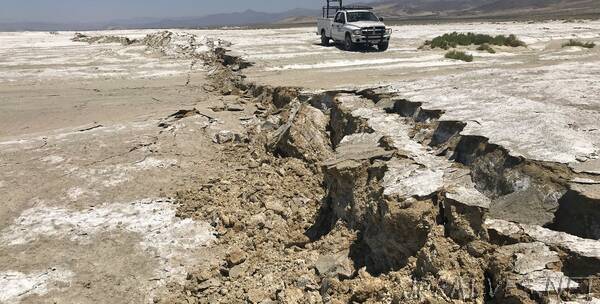
“In California, thousands of miles of fiber optic cables crisscross the state, providing people with internet. But these underground cables can also have a surprising secondary function: they can sense and measure earthquakes. In a new study at Caltech, scientists report using a section of fiber optic cable to measure intricate details of a magnitude 6 earthquake, pinpointing the time and location of four individual asperities, the “stuck” areas of the fault, that led to the rupture.
For several years, Professor of Geophysics Zhongwen Zhan (PhD ‘14) and his team have aimed to show that repurposing fiber optic cables is a simple way to drastically expand our ability to measure seismic activity by producing a dense network of makeshift seismometers in a method called distributed acoustic sensing. The new study, appearing in the journal Nature, utilized only a 100-kilometer section of cable to precisely understand the complex mechanics behind a particular 2021 earthquake, suggesting that access to more cables would enable improved understanding of earthquake physics and ultimately better earthquake early-warning systems.
“If we can get broader coverage to measure seismic activity, we can revolutionize how we study earthquakes and provide more advance warning,” says Zhan. “Though we cannot predict earthquakes, distributed acoustic sensing will lead to a better understanding of the details underlying how the earth ruptures.”
There are about 500 seismometers throughout the roughly 56,500 square miles in Southern California, and each one costs up to $50,000. On the other hand, utilizing fiber optic cables throughout the state could be equivalent to blanketing it with millions of seismometers.
To use a fiber optic cable as a seismometer, laser emitters are stationed at one end of the cable, shooting beams of light through the long, thin glass strands that make up the cable’s core. The glass has tiny imperfections that reflect back a minuscule portion of the light to the source, where it is recorded. In this manner, each imperfection acts as a trackable waypoint along the fiber optic cable, which is typically buried just below ground level. Seismic waves moving through the ground cause the cable to wiggle slightly, which changes the travel time of light to and from these waypoints. Thus, the imperfections along the cable’s length act like thousands of individual seismometers that allow seismologists to observe the motion of seismic waves.
In this new study, the team examined the light signatures traveling through a stretch of fiber optic cable located in the Eastern Sierra Nevada during the 2021 Antelope Valley magnitude 6 earthquake. The section of cable was equivalent to 10,000 seismometers and was able to discover that the M6 was made up of a sequence of four smaller ruptures. These so-called “sub-events,” like mini earthquakes, could not be detected by a conventional seismic network.
In collaboration with the laboratory of Nadia Lapusta, the Lawrence A. Hanson, Jr., Professor of Mechanical Engineering and Geophysics, the team was able to create an accurate model of the M6 earthquake based on the measured seismic activity. The model showed the timing of the four sub-events and pinpointed their exact locations on the fault region.
“Using fiber optic cable as a series of seismometers reveals aspects of earthquake physics that have long been hypothesized but difficult to image,” says Zhan. “As an analogy, imagine your everyday backyard telescope. You can see Jupiter, but you probably can’t see its moons or any details. With a really powerful telescope, you can see the fine details of the planet and moon surfaces. Our technology is like a powerful telescope for earthquakes.”
The paper is titled “The break of earthquake asperities imaged by distributed acoustic sensing.” Jiaxuan Li, postdoctoral scholar research associate in geophysics, is the study’s first author. In addition to Zhan, Li, and Lapusta, additional co-authors are graduate student Taeho Kim and DAS scientist Ettore Biondi. Funding was provided by the National Science Foundation.”
